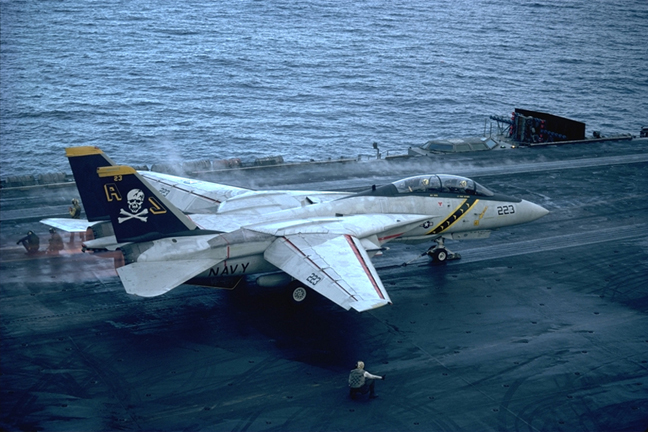
F-14 from VF-84 "Jolly Rogers" prepares for launch. Picture from Voodoo.cz.
One of the premier fighters in the history of aviation, and the most storied fighter in the U.S. inventory, has returned from deployment for the last time.
The F-14 Tomcat, a swing-wing twin-engined fighter-interceptor, is slated for retirement as the last active-duty squadrons still flying the F-14 returned to Oceana Naval Air Station. The squadrons will be re-equipped with the F/A-18 Super Hornet.
That would be despite the fact that the F-14 is still a better fighter. The problem is age - the F-14 has been in active service since 1973; the F-18 design is a good ten years younger, while the Super Hornet design is younger still, with models not entering service until the early 1990s. Older planes need more maintenance time. The maintenance demands are forcing the F-14 out of service.
Makes you wonder, though; maybe they ought to just build some new F-14s, with new electronics. The basic design is still a good one. The new F-18s are slower and heavier that the older F-14s.
But the threat has changed as well. The F-14 was an answer to the Soviet threat, a way to keep Warsaw Pact bombers and fighters away from NATO convoys in case everybody's nightmares came true. (See Tom Clancy's Hunt for Red October or even better, Red Storm Rising, to see how the Tomcats were used and were intended to be used.) For naval aviation, the need now isn't so much to defend against enemy aircraft as to be able to strike deep into enemy territory.
I just hope we're not ignoring tomorrow's war while preparing for today's.
For more information:
The F-14 Tomcat Association
Wikipedia
FAS.org
Voodoo.cz
Tomcat Alley
Technography
UPDATE: A couple of looks back...
Neptunus Lex
Chaotic Synaptic Activity, Part I and Part II
Instapinch, Tomcats, Oceana Fly-in Part I, Part II, Part III







No comments:
Post a Comment